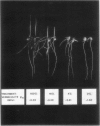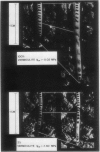Abstract
Seedlings of maize (Zea mays L. cv WF9 × Mo 17) were grown in vermiculite at various water potentials. The primary root continued slow rates of elongation at water potentials which completely inhibited shoot growth. To gain an increased understanding of the root growth response, we examined the spatial distribution of growth at various water potentials. Time lapse photography of the growth of marked roots revealed that inhibition of root elongation at low water potentials was not explained by a proportional decrease in growth along the length of the growing zone. Instead, longitudinal growth was insensitive to water potentials as low as − 1.6 megapascal close to the root apex, but was inhibited increasingly in more basal locations such that the length of the growing zone decreased progressively as the water potential decreased. Cessation of longitudinal growth occurred in tissue of approximately the same age regardless of spatial location or water status, however. Roots growing at low water potentials were also thinner, and analysis revealed that radial growth rates were decreased throughout the elongation zone, resulting in greatly decreased rates of volume expansion.
Full text
PDF







Images in this article
Selected References
These references are in PubMed. This may not be the complete list of references from this article.
- Cornish K., Zeevaart J. A. Abscisic Acid Accumulation by Roots of Xanthium strumarium L. and Lycopersicon esculentum Mill. in Relation to Water Stress. Plant Physiol. 1985 Nov;79(3):653–658. doi: 10.1104/pp.79.3.653. [DOI] [PMC free article] [PubMed] [Google Scholar]
- Greacen E. L., Oh J. S. Physics of root growth. Nat New Biol. 1972 Jan 5;235(53):24–25. doi: 10.1038/newbio235024a0. [DOI] [PubMed] [Google Scholar]
- Kurth E., Cramer G. R., Läuchli A., Epstein E. Effects of NaCl and CaCl(2) on Cell Enlargement and Cell Production in Cotton Roots. Plant Physiol. 1986 Dec;82(4):1102–1106. doi: 10.1104/pp.82.4.1102. [DOI] [PMC free article] [PubMed] [Google Scholar]
- Michelena V. A., Boyer J. S. Complete turgor maintenance at low water potentials in the elongating region of maize leaves. Plant Physiol. 1982 May;69(5):1145–1149. doi: 10.1104/pp.69.5.1145. [DOI] [PMC free article] [PubMed] [Google Scholar]
- Robertson J. M., Pharis R. P., Huang Y. Y., Reid D. M., Yeung E. C. Drought-induced increases in abscisic Acid levels in the root apex of sunflower. Plant Physiol. 1985 Dec;79(4):1086–1089. doi: 10.1104/pp.79.4.1086. [DOI] [PMC free article] [PubMed] [Google Scholar]
- Silk W. K., Erickson R. O. Kinematics of plant growth. J Theor Biol. 1979 Feb 21;76(4):481–501. doi: 10.1016/0022-5193(79)90014-6. [DOI] [PubMed] [Google Scholar]
- Silk W. K., Hsiao T. C., Diedenhofen U., Matson C. Spatial distributions of potassium, solutes, and their deposition rates in the growth zone of the primary corn root. Plant Physiol. 1986 Nov;82(3):853–858. doi: 10.1104/pp.82.3.853. [DOI] [PMC free article] [PubMed] [Google Scholar]
- Silk W. K., Walker R. C., Labavitch J. Uronide Deposition Rates in the Primary Root of Zea mays. Plant Physiol. 1984 Mar;74(3):721–726. doi: 10.1104/pp.74.3.721. [DOI] [PMC free article] [PubMed] [Google Scholar]
- Twente J. W., Twente J. A. Regulation of hibernating periods by temperature. Proc Natl Acad Sci U S A. 1965 Oct;54(4):1044–1051. [PMC free article] [PubMed] [Google Scholar]




